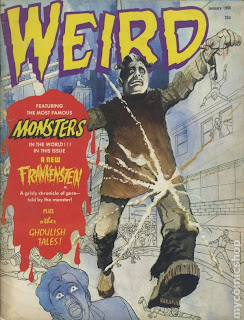The Weird World Of Eerie Publications
by Mike Howlett (2010)
Recommended by Mike
It was my birthday.
Kathryn directed me to an unlabelled VHS tape.
‘It’s from me and someone
else,’ she said. ‘Play it! Play it!’
I screamed in delight and
threw my arms around her.
‘Turn it off now,’ Kathryn
said, as the title sequence finished. ‘I’m not watching it.’
Cannibal Holocaust, for the uninitiated,
is a notorious video nasty. You can get a flavour of it from this trailer
(NSFW):
Even when considered in
the later context of torture porn films like Hostel, Cannibal Holocaust is
repulsive and intense in its imagery. But, (very unlike Hostel) it has a great deal to say about serious subjects – such as
authenticity, Western anthropological assumptions, media exploitation of
culture, and the abuse of animals. I’d wanted to see this film, (then) banned
and very difficult to get hold of, for years.
So how did Kathryn, who
avoids horror movies at all costs, track down Cannibal Holocaust?
The answer is Mike.
Kathryn and Mike ‘met’ on
an indie-pop message board. I find it utterly brilliant that my first
introduction to Mike was through Cannibal
Holocaust, while Kathryn’s was through songs like this:
Mike is American, and he
and I began writing letters to one another. Through our correspondence, I found
out that he loved horror movies of all eras and styles. My own palate was then
fixated on stylized 1970s Euro-horror and nihilistic American efforts like Last House On The Left, and I credit Mike
with considerably broadening my tastes.
So when I asked Mike for a
book recommendation, he came up with a lavishly illustrated and unapologetically
nerdy history of a gruesome comic book company. What kind of person would write
a book like this?
Mike would. And he did!
If anyone’s thinking Mike
recommended this book to me in order to promote it, I can guarantee that’s the
furthest thing from his mind. I know exactly why this most generous and
enthusiastic of souls sent me this: so I could understand and love the very
weird world of Eerie Publications for myself. If he’d not written this book, he
probably would have shipped me over two dozen original comics instead.
Weird and its clammy ‘the world’s gone to shit’ brand of horror was one of
the few pop harbingers of what was just around the corner.
Weird, along with Terror Tales, Horror Tales, Tales Of Voodoo, Witches’ Tales, Tales From
The Tomb and many other shorter-lived titles, represented the empire of
Myron Fass. Fass, a mixture of opportunistic capitalist and deranged gun-toter,
cut his teeth in the early 1950s horror comics boom. Blood and oddness had run
riot during this period, but it didn’t last. In 1954, the quasi-academic tract Seduction Of The Innocent tenuously claimed
horror comics had a deleterious effect on children, and it ushered in an era of
censorship (‘the code’): the comics’ bloodletting was stemmed, and
unsurprisingly no-one wanted the new neutered stories. Horror comics were over.
Fast-forward a decade. In
January 1966, this hit American newsstands.
The first Weird reprinted
seven pre-code horror stories […] In some panels, a few extra drops of blood
were added to the original art to make it a bit more gruesome.
Myron Fass had hundreds of
these 1950s horror stories to mine. Once he’d printed ‘em up on cheap paper (with
even cheaper ink that turned a reader’s fingers to charcoal) all Fass had to do
was commission new covers.
And what covers they were:
a sick, wonderful art form in themselves. In this book, Howlett generously
reprints every single one (and the best get their own full-page glory). Check
out the human corn-on-the-cob!
And the meat grinder!
The titles were
successful, and because Fass now had so very many horror comics on the go,
those 1950s stories were running dry. Did he commission new stories? Did he
buggery! The man was allergic to paying for stuff. He went for the cheapest
option: to give the impression of freshness, he got artists to redraw those
same 1950s stories, retaining the original dialogue balloons and text, but with
instructions to gore them up. A new title, and voila: a ‘new’ story.
However, it was this very
workhouse that gave some talented artists freedom. They creatively interpreted
the 1950s material, playing with panels, perspective and character. As long as
they also shoved in an eye trauma or a disembowelment, Fass couldn’t care less
if they indulged their artier side. Finally, even the redraw tactic ran dry and
new stories were grudgingly included, but reprints of the same ancient shit
continued right up to the magazines’ dying days in the mid-1970s.
I think my favourite part
of the Eerie Publications story was the ultra-bizarre short-lived projects. Look at the mixture of Lady Gaga
and Fantastic Planet that was Gasm, from November 1977…
…and the obligatory Star Wars cash-in with amusing copyright-dodging name!
There was even a magazine on the Swine Flu epidemic of 1976! Was there nothing this man couldn't exploit?
I’m so made-up for Mike.
This book is a brilliant achievement. With specialist geeky subjects like this,
the writing is often stale, but that’s not the case at all with The Weird World Of Eerie Publications.
Mike is as funny and lovely in print as he is in real life, and I’m really
proud that he’s my friend.
















